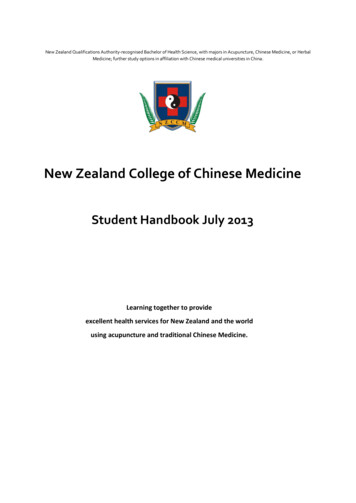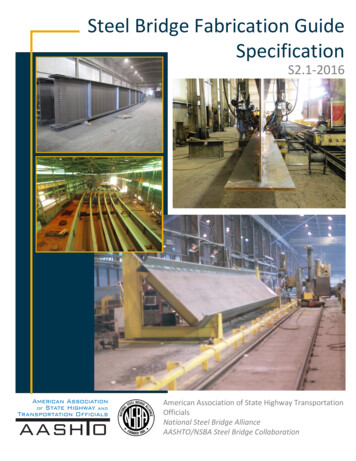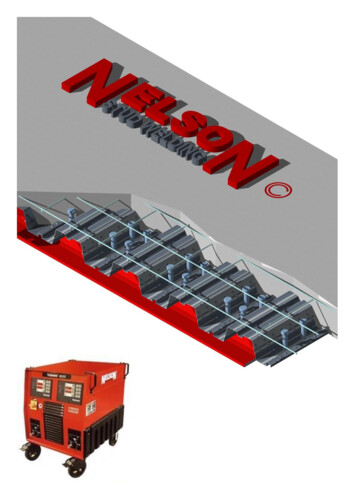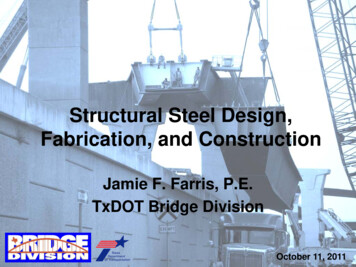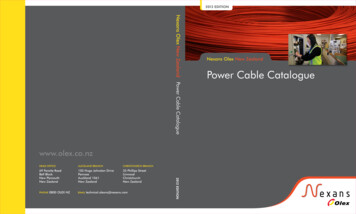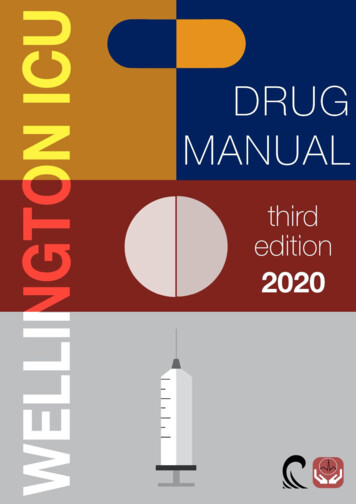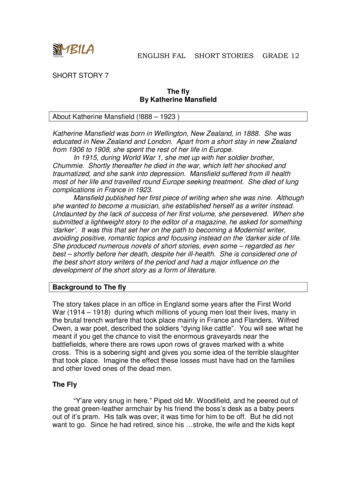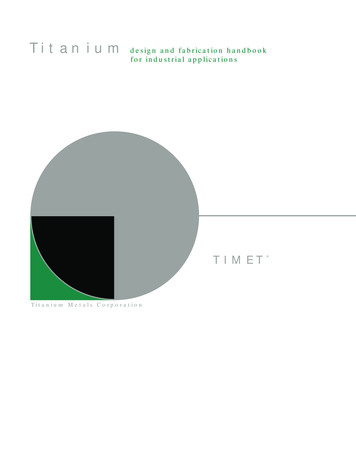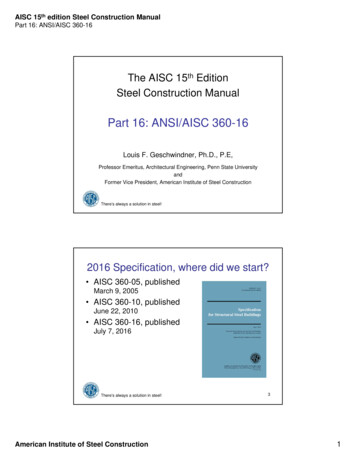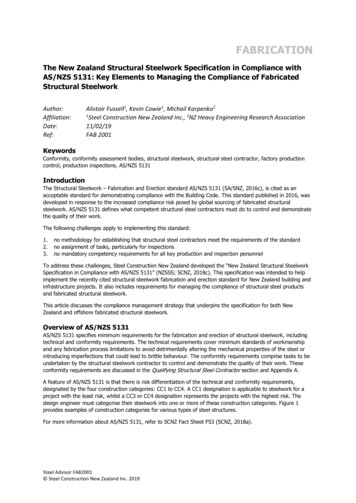
Transcription
FABRICATIONThe New Zealand Structural Steelwork Specification in Compliance withAS/NZS 5131: Key Elements to Managing the Compliance of FabricatedStructural SteelworkAuthor:Affiliation:Date:Ref:Alistair Fussell1, Kevin Cowie1, Michail Karpenko21Steel Construction New Zealand Inc., 2NZ Heavy Engineering Research Association11/02/19FAB 2001KeywordsConformity, conformity assessment bodies, structural steelwork, structural steel contractor, factory productioncontrol, production inspections, AS/NZS 5131IntroductionThe Structural Steelwork – Fabrication and Erection standard AS/NZS 5131 (SA/SNZ, 2016c), is cited as anacceptable standard for demonstrating compliance with the Building Code. This standard published in 2016, wasdeveloped in response to the increased compliance risk posed by global sourcing of fabricated structuralsteelwork. AS/NZS 5131 defines what competent structural steel contractors must do to control and demonstratethe quality of their work.The following challenges apply to implementing this standard:1.2.3.no methodology for establishing that structural steel contractors meet the requirements of the standardno assignment of tasks, particularly for inspectionsno mandatory competency requirements for all key production and inspection personnelTo address these challenges, Steel Construction New Zealand developed the “New Zealand Structural SteelworkSpecification in Compliance with AS/NZS 5131” (NZSSS; SCNZ, 2018c). This specification was intended to helpimplement the recently cited structural steelwork fabrication and erection standard for New Zealand building andinfrastructure projects. It also includes requirements for managing the compliance of structural steel productsand fabricated structural steelwork.This article discusses the compliance management strategy that underpins the specification for both NewZealand and offshore fabricated structural steelwork.Overview of AS/NZS 5131AS/NZS 5131 specifies minimum requirements for the fabrication and erection of structural steelwork, includingtechnical and conformity requirements. The technical requirements cover minimum standards of workmanshipand any fabrication process limitations to avoid detrimentally altering the mechanical properties of the steel orintroducing imperfections that could lead to brittle behaviour. The conformity requirements comprise tasks to beundertaken by the structural steelwork contractor to control and demonstrate the quality of their work. Theseconformity requirements are discussed in the Qualifying Structural Steel Contractor section and Appendix A.A feature of AS/NZS 5131 is that there is risk differentiation of the technical and conformity requirements,designated by the four construction categories: CC1 to CC4. A CC1 designation is applicable to steelwork for aproject with the least risk, whilst a CC3 or CC4 designation represents the projects with the highest risk. Thedesign engineer must categorise their steelwork into one or more of these construction categories. Figure 1provides examples of construction categories for various types of steel structures.For more information about AS/NZS 5131, refer to SCNZ Fact Sheet FS3 (SCNZ, 2018a).Steel Advisor FAB2001 Steel Construction New Zealand Inc. 2019
Figure 1 Examples of construction categories for various types of steel structuresElements of NZSSS Dedicated to Quality ManagementThe key elements utilised in the specification for managing compliance are: Qualifying requirements for structural steel contractorsDocumentation reviewIndependence of inspectionsGood sourcing practices for structural steel productsEach of these elements will be discussed in the following sections.Qualifying Structural Steel ContractorsAS/NZS 5131 RequirementsAS/NZS 5131 does not address how structural steel contractors are qualified for structural steelwork contracts.The key conformity requirements in AS/NZS 5131 to control and demonstrate the quality of a structural steelcontractor’s work are:1.2.3.4.5.Competent personnelFit for purpose, regularly maintained, and calibrated equipmentProcedures for controlling key manufacturing processes. Control of the welding process is an importantelement of the standard. It is recommended weld quality management is accordance with therequirements of AS/NZS ISO 3834 – Quality requirements for fusion welding of metallic materials(SA/SNZ, 2008)Inspection and test plans to demonstrate conformity of workmanship with the technical requirementsof the standardA quality management system (QMS) under which all fabrication and erection processes operateItems 1-4 equate to a factory production control (FPC) system whereas item 5 is a QMS. Both FPC and QMS arediscussed in Appendix A.AS/NZS 5131 does not address how compliance with the conformity requirements of the standard are assessed.This deficiency means that it can be challenging for builders and tender evaluation teams to identify structuralsteel contractors who comply with the requirements of the standard.2
The standard does, however, provide a basis for establishing a third-party structural steel contractor certificationscheme to identify companies who do meet the requirements of the standard such as the HERA Certifications LtdSteel Fabrication Certification (SFC) Scheme. This provides the simplest and most reliable approach to qualifyingstructural steel contractors for structural steelwork contracts. For more information about the SFC scheme, referwww.steelfabcert.co.nz.NZSSS RequirementsThe NZSSS specifies structural steel contractors are qualified for structural steelwork contracts by: Certification under the HERA Certifications Ltd Steel Fabrication Certification (SFC) Scheme orDesktop review of a compliance document submitted at tender time demonstrating how the structural steelcontractor will meet the requirements of AS/NZS 5131. Qualification by the desktop route is subject toEngineer and Principal approval and additional requirements apply. The additional requirements arediscussed in the following paragraphs.Two recommendations are also given in the informative notes in the Fabricator Qualification section of theNZSSS:1.2.The tender evaluation team engage specialist expertise to review the compliance document submitted (ifstructural steel contractor qualification is by the desktop review route.) The rationale for this is that tenderevaluation teams typically do not have the specialist knowledge to assess the compliance or otherwise of astructural steel contractor from the documentation providedFor construction category 3 and 4 projects (high risk projects), the use of non SFC certified structural steelcontractors should only be limited to those who have some form of independent assessment andcertification of their capability. Less robust alternatives to SFC certification are:a. ISO 3834 - Quality requirements for fusion welding of metallic metals (ISO, 2005) and ISO 9001 –Quality Management Systems – Requirements (ISO, 2015)b. Certification under an international certification schemeA compliance document must still be submitted for structural steel contractors with alternative certifications inorder to demonstrate how they will comply with the requirements of AS/NZS 5131 outside the scope of theircertification. Alternative structural steel contractor certifications to SFC certification are discussed in Appendix A.If a structural steel contractor is qualified by the desktop route, additional requirements apply. There is anincreased requirement for documentation review and independent inspections. The additional documentationreview and independent inspections are discussed in the following sections. The rationale for these additionalrequirements is that desktop review of a compliance document is a less robust approach to establishingstructural contractor compliance with the requirements of AS/NZS 5131 than factory audit and certification underthe SFC scheme.An additional consideration for a desktop review qualified structural steel contractor is that the compliancedocument may have been prepared solely for the purpose of the tender bid and does not represent standardoperating practice for the company. It is therefore important that the construction reviewer ensures thestructural steel contractor adheres to the conformity procedures submitted in the compliance document duringfabrication and erection of the contract works.Documentation ReviewAS/NZS 5131 RequirementsAS/NZS 5131 requires the structural steel contractor to have the following documentation:1.2.3.4.5.6.Quality documentationQuality management systemQuality plan (only mandatory for CC3 and CC4 projects unless specified in contract documents)Inspection and test plansShop drawingsManufacturer data records (checklists, inspection documentation, test reports etc)Items 1 and 2 represent the structural steel contractor’s written standard operating procedures for controllingquality while items 3,4,5 and 6 are specific to a particular contract. Items 1 and 2 are discussed in Appendix A.3
NZSSS RequirementsThe NZSSS differentiates between the documentation requested from the structural steel contractor for review,depending on the qualification route taken. The documentation review requirements are as follows:SFC Qualified Structural Steel Contractor1.2.3.Inspection and test planShop drawingsManufacturer dataDesk-top Review Qualified Structural Steel Contractor1.2.3.4.5.6.Quality documentationQuality plan (if required)Personnel list (supervisors/inspectors)Inspection and test planShop drawingsManufacturer data reportItem 1, and possibly 2 and 3 in the second list may be addressed at the tender stage as part of the desktopreview of the structural steel contractor’s compliance document. Items 4 and 5 will be reviewed at the posttender stage, prior to fabrication beginning. Item 6 will generally be reviewed at the end of the project asevidence that the structural steel contractor has operated its factory production and quality managementsystems. The only exception to this timeframe is that the inspection documentation for the structural steel shouldbe reviewed prior to any fabrication beginning. This recommendation is applicable to SFC and desktop qualifiedstructural steel contractors.The reason there is less documentation required to be submitted and reviewed by the project engineer/construction reviewer for SFC certified structural steel contractors, is that the quality documentation and qualityplan requirements are addressed as part of their SFC audit and certification process.The manufacturer’s data report (6) will contain an extensive amount of information. The required manufacturerdata to be supplied for review by the construction reviewer is construction category dependent, this is specifiedin the NZSSS.It is recommended that appropriate expertise is contracted to assist the construction reviewer review thedocumentation submitted by non-SFC certified structural steel contractors.Independent InspectionAS/NZS 5131 RequirementsDocumented inspection and test plans are required for structural steelwork fabricated and erected to theconstruction category 2, 3 and 4 requirements of AS/NZS 5131. Inspections are to be undertaken by competentpersonnel. Inspection and test plans are required to cover all key processes including:1.2.3.4.5.6.7.8.Material and componentsPreparation and assemblyWeldingMechanical fasteningsSurface treatmentPaint coatingsGalvanized coatingsErectionThere are, however, limitations with the inspection provisions of the standard in terms of the definition ofcompetency and independence of inspections. With respect to competency, AS/NZS 5131 provides only limitedguidance on the minimum qualifications and relevant experience of inspectors. Qualifications are mandated forwelding inspectors while those given for coatings inspectors are guidelines only. Informative guidance is alsoprovided in AS/NZS 5131 for the minimum relevant experience required for inspectors.4
AS/NZS 5131 does not address the matter of independence of inspection because it does not specify who shouldbe undertaking inspections and testing. They could be first party (structural steel contractor), second party(independent party engaged by the structural steel contractor) or third party (independent party engaged by thebuilder or the principal) inspectors.Historically, items 1, 2, 4, and 8 have been undertaken in-house by the structural steel contractor. The visualinspection of item 3 (welding) has traditionally been undertaken in-house, provided that the structural steelcontractor has appropriately qualified personnel. Non-visual examination (ultrasonic, radiographic), however, hasusually been contracted to an independent weld inspection company and paid for by the structural steelcontractor. Guidance on the independence of surface treatment (item 5) and paint coatings (item 6) inspectionshas been provided in AS/NZS 2312.1 (SA/SNZ, 2014a). In this document, the independence of inspections isgoverned by the performance demand of the system, either the service environment or the extent of surfacepreparation required for the system. AS/NZS 5131 recognises the performance demand of coating systems byway of coating quality levels, PC1 and PC2. The NZSSS independence of inspection requirements for surfacetreatment and coatings inspections are based on the AS/NZS 5131 coating quality levels.NZSSS RequirementsThe NZSSS inspection requirements include independence of inspections not addressed in AS/NZS 5131 andmandatory qualifications for welding, surface preparation and coatings inspectors. This contrasts with AS/NZS5131, which only provides guidelines on the surface preparation and coatings inspector qualificationrequirements.The extent of independent inspections is dependent on whether the structural contractor is SFC certified or not.These requirements, taken from Appendix C of the NZSSS, are as follows:SFC Certified Structural Steel ContractorIndependent Inspection AreaRequiredCC2CC3/CC4Materials and ComponentsPreparation, Assembly and FabricationWelding (visual*) Welding (non visual – radiographic/ ultrasonic)Fastening Surface Treatment (PC2 only) Paint Coatings (PC2 only)) Galvanised Coatings (if required)ErectionNB Independent inspectors may cover more than one area*Contingent on the structural steel contractor having suitably qualified in-house weld inspection personnelNon SFC Certified Structural Steel ContractorIndependent Inspection AreaMaterials and ComponentsPreparation, Assembly and FabricationWelding (visual and non-visual)FasteningSurface Treatment (PC2 only)Paint Coatings (PC2 only)Galvanised Coatings (if required)ErectionNB Independent inspectors may cover more than one areaRequiredCC2 CC3/CC4 The philosophy underpinning the specification inspection requirements is that when using non-certified structuralsteel contractors, increased independent inspections are required to help manage the increased quality riskassociated with such structural steelwork contractors. Consistent with a risk-based approach, the extent of itemsrequiring independent inspection in the NZSSS increases with the project risk (construction category) andstructural steel contractor risk.5
One point to note is that the specification recommends that independent inspection be paid for by the builder notthe principal as the builder is the party responsible for constructing the structure in accordance with the contractdocuments. An important requirement for independent inspection personnel is that they must have suitabletraining and experience with New Zealand standards and steelwork of similar scale and complexity of thecontract. The requirement for inspection personnel to have relevant training and experience in New Zealandfabrication and welding standards is important for offshore fabrication. The appointment of independentinspectors by the builder is subject to the approval of the construction reviewer.Good Practice Sourcing of Structural Steel ProductsIntroductionSCNZ has recently published a series good practice documents for sourcing compliant structural steels, structuralfasteners, and anchor bolts to address deficiencies in the current compliance regime in New Zealand forconstruction products. Under this compliance regime, there is no requirement for the independent assessment ofthe capability of a manufacturer or the quality of their products.The following good practice documents are available from the SCNZ website (www.scnz.org):1.2.3.New Zealand Guide to the Sourcing of Compliant Structural Steels (Fussell, Cowie, Hicks, & Karpenko, 2018)Practice Note on the Sourcing of Compliant High Strength Structural Bolts (Cowie, Hicks, & El Sarraf, 2018)Practice Note on the Sourcing of Threaded Rod for Foundation Bolts (Cowie & Fussell, 2018)The principle underpinning all three publications is that third parties must be involved in verifying thecompetency of manufacturers and/or conformity of their steel products.AS/NZS 5131 RequirementsThere is a requirement in AS/NZS 5131 for steel products and components to be supplied to structural steelcontractors with inspection documentation (test certificates or reports). The purpose of this documentation is toallow them to check that the supplied products meet the requirements of the contract specification.A weakness of AS/NZS 5131 is that this standard does prescribe what inspection documentation constitutesadequate evidence of compliance with a given supply standard. The inspection documentation can be first(manufacturer), second (purchaser) or third (independent) party declarations of conformity. Unless requestedotherwise, inspection documentation will typically be first party statement of conformity by the manufacturer.First party (manufacturer) assessment and declaration of conformity is deemed inadequate evidence ofconformity in a global sourcing market.NZSSS RequirementsStructural SteelsThe NZSSS requires structural steels to be sourced in accordance with the New Zealand Guide to SourcingCompliant Structural Steels, including the documented evidence of compliance which must accompany thesupplied structural steel.For details of the Guide to Sourcing Compliant Structural Steels, refer to the SCNZ fact sheet FS4 (SCNZ, 2018b)Structural FastenersNZSSS specifies two options for sourcing high strength structural fasteners to the AS/NZS 1252 supply standard.High strength structural fasteners can be supplied to the 1996 and the 2016 revisions of AS/NZS 1252. Themajority of fasteners to the New Zealand market are supplied to the 1996 revision. Regardless of which AS/NZS1252 standard structural fasteners are supplied to, the NZSSS requires the importer to verify product qualitythrough independent testing and inspection in accordance with:1.2.Steel Advisor article Mat 1010 entitled “Practice Note on the Sourcing of Compliant High StrengthStructural Bolts” (Cowie et al., 2018) orAS/NZS 1252.2 – High Strength Steel Fasteners for Bolt Assemblies – Part 2: Verification testing for boltassemblies (SA/SNZ, 2016b)Option 1 applies to bolts sourced to the 1996 revision of AS/NZS 1252 while option 2 is applicable to the 2016revision.Unfortunately, the 1996 revision of AS/NZS 1252 contains no mandatory conformity requirements, includinginspection and test requirements or the operation of factory production control. Compounding this issue, high6
strength structural fasteners are typically of Chinese origin. (The lack of mandatory product conformityrequirements was addressed in AS/NZS 1252.1:2016 (SA/SNZ, 2016a) and AS/NZS 1252.2:2016 (SA/SNZ,2016b).) The latter specifies requirements for verification testing and inspections to be undertaken by thefastener importer to provide additional assurance of bolt quality.To manage the transition from AS/NZS 1252:1996 supply to AS/NZS 1252.1:2016, an industry fastener supplyworking group comprising bolt importers, structural steel contractors, and structural engineers was convened in2017. An outcome of this working group was a Steel Advisor article MAT 1010. This article features a samplingand test plan for third-party testing and inspections to be undertaken on behalf of the importer to provideadditional assurance of bolt quality when supplying fasteners to the 1996 revision of AS/NZS 1252. Thisinspection and testing is a limited form of verification testing to that specified in AS/NZS 1252.2.Anchor BoltsThe NZSSS anchor bolt sourcing requirement is that the quality of threaded rods used to connect structuralsteelwork to their foundations must be established by testing in accordance with Steel Advisor MAT 1011 (Cowie& Fussell, 2018). Furthermore, product shall be supplied with inspection documentation as per MAT 1011.In New Zealand, threaded rod for anchor bolts is typically supplied to the DIN 976.1 standard (GIS, 2016)because there is no AS/NZS supply standard that meets the anchor bolt performance requirements of AS/NZS5131.The supply of anchor bolts has a similar compliance risk profile to that of structural fasteners supplied to AS/NZS1252.1996. This risk requires managing as the DIN 976-1 standard contains no mandatory conformityrequirements for anchor bolts and, furthermore, these are usually manufactured in China.The industry fasteners supply working group also addressed the anchor bolt compliance risk in the form of aSteel Advisor article MAT 1011, entitled “Practice Note on the Sourcing of Threaded Rod Used for FoundationBolts”. This article establishes the equivalency of the DIN 976.1 standard with the mechanical and chemicalrequirements of AS/NZS 5131 and presents verification tests to be undertaken by the importer in order toprovide additional confidence in the quality of supplied threaded rods.Use of Non-Prequalified Structural SteelsThe Steels Structures Standard NZS 3404.1 permits the use of three types of steels:Prequalified SteelsThese are structural steels manufactured to a prescribed selection of AS/NZS, EN, and JIS material standards.Such steels may be used without any further assessment or approval to justify their use with NZS 3404.Alternative Steels (non-Prequalified Steels)Structural steels manufactured to an international steel supply standard approved by an appropriate expert ascompatible for use with the steel structures and welding standards (NZS 3404 and AS/NZS 1554.1) This approvalprocess is outside the scope of NZS 3404 as a Verification Method for the NZ Building CodeUnidentified SteelsThese are steels for which the grade is no longer identifiable. Such steels may be used subject to the followingrequirements:ooEstablish design parameters fy, fu based on test data using an appropriate statistical method.Such a method is presented in appendix E of (Fussell, Cowie, Hcks & Karpenko , 2018), orAssume conservative design parameters fy and fu, 170 MPa and 300 MPa respectively and limittheir use to elastic applications.Principles for justifying the use of alternative steels are discussed in (Chung, Chiew, & Lee, 2015; BCA, 2013) butit must be noted that the significant issue of structural reliability is not addressed in these publications. Structuralreliability is the process of calibrating the design rules in limit state design standards to ensure a low probabilityof failure during the life of the structure. Strength reduction factors ( ) produced by this calibration process areapplied to the design rules in NZS 3404. To determine these strength reduction factors, assumptions have beenmade concerning the geometric and mechanical properties of structural steels that will be used in conjunctionwith this design standard. The process of justifying the use of alternative structural steels must consider whether7
the use of such steels will render the strength reduction factors in NZS 3404 invalid. This matter of structuralreliability is the topic of a current SCNZ/ HERA research project.Implementation of AS/NZS 5131 – NZ Steelwork Specification in Compliancewith AS/NZS 5131 ApproachAs noted previously, a weakness of AS/NZS 5131 is that it does not address how the requirements of thestandard are implemented. In particular it does not address who is responsible for the various tasks and at whatstage of the structural steelwork process they should be undertaken. Furthermore, it is not clear what structuralsteel contractor documentation is required to be reviewed by the project engineer/ construction reviewer. TheNZSSS is intended to address these problems. In addition, the NZSSS provides a risk-based approach to managethe compliance of structural steelwork. To illustrate how the NZSSS requirements are implemented, a diagramoverviewing the key stages of the structural steelwork procurement process has been prepared, see Appendix B.This diagram should be read in conjunction with Appendices A, B, and C of the NZSSS.ConclusionThe recently published structural steelwork fabrication and erection standard AS/NZS 5131 was developed toaddress the increased compliance risk posed by the global sourcing of structural steelwork. Whilst this documentcontains tools to assist in managing the compliance of structural steelwork manufactured to this standard, thestandard does not specifically address how they should be used. The recently published New Zealand StructuralSteelwork Specification in Compliance with AS/NZS 5131 is intended to address this deficiency. The key elementsutilised in the NZSSS to manage the quality of structural steelwork have been discussed in this article, includingrequirements for qualifying structural steelwork contractors via a certification or desktop review routes,documentation review, the use of independent inspectors, and good practice sourcing of structural steelproducts. Each of these elements involves the use of third-party conformity assessment bodies, which are anessential element of the risk-based approach presented in the NZSSS document. The roles of third-partyconformance bodies will be discussed in future practice notes.8
ReferencesASQ. (n.d.). What is a quality management system (QMS)? ISO 9001 & other quality managementsystems. Retrieved from nt-systemBSI. (n.d.). Put quality at the heart of your business: Upgrade your factory production control systemto ISO 9001:2015. Retrieved 20and%209K%20whitepaper%20webFINAL.pdfBuilding and Construction Authority (BCA). (2013). Design guide on use of alternative structuralsteels to BS 5950 and Eurocode 3. (BC1: 2012). Retrieved esign guide bc1 2012.pdfCEN. (2008). Execution of steel structures and aluminium structures - Part 2: Technical requirementsfor steel structures. (EN 1090-2: 2008 A1: 2011). Brussels, Belgium: European Committee forStandardization.Chung, K., Chiew, S., and Lee, H. (2015). Selection of equivalent steel materials to European steelmaterials specifications. Retrieved from uropean-SteelMaterials-Specifications.pdfCowie, K., & Fussell, A. (2018, February 20). Practice note on the sourcing of threaded rod used forfoundation bolts. Steel Advisor, (MAT1011).Cowie, K., Hicks, S., & El Sarraf, R. (2018, March 20). Practice note on the sourcing of compliant highstrength structural bolts. Steel Advisor, (MAT1010).Fussell, A., Cowie, K., Hicks, S., & Karpenko, M. (2018). New Zealand guide to the sourcing ofcompliant structural steels. (Report no. 111, 2018). Auckland, New Zealand: SCNZ Inc.GIS. (2016). Fasteners - Stud bolts - Part 1: Metric thread. (DIN 976-1:2016-09). Berlin, Germany:German Institute for Standardization.ISO. (2005). Quality requirements for fusion welding. (ISO 3834). Geneva, Switzerland: InternationalOrganization for Standardization.ISO. (2015). Quality management systems – requirements. (ISO 9001). Geneva, Switzerland:International Organization for Standardization.Karpenko, M. (2016). The welding co-ordination team in AS/NZS ISO 3834 [Notice]. Retrieved fromHERA website: asnzsiso3834/SA/SNZ. (2008). Quality requirements for fusion welding of metallic materials. (AS/NZS ISO 3834).Sydney, Australia/Wellington, New Zealand: Standards Australia/Standards New Zealand.SA/SNZ. (2014a). Guide to the protection of structural steel against atmostpheric corrosion by the useof the protective coatings - Part 1: Paint coatings. (AS/NZS 2312.1:2014). Sydney,Australia/Wellington, New Zealand: Standards Australia/Standards New Zealand.SA/SNZ. (2014b). Structural steel welding - Part 1: Welding of steel structure. (AS/NZS 1554.1).Sydney, Australia/Wellington, New Zealand: Standards Australia/Standards New Zealand.SA/SNZ. (2016a). High-strength steel fastener assesmblies for structural engineering - Bolts, nuts andwashers. Part 1: Technical requirements. (1252.1). Sydney, Australia/Wellington, NewZealand: Standards Australia/Standards New Zealand.SA/SNZ. (2016b). High-strength steel fastener assemblies for structural engineering - Bolts, nuts andwashers. Part 2: Verification testing for bolt assemblies. (1252.2). Sydney,Australia/Wellington, New Zealand: Standards Australia/Standards New Zealand.SA/SNZ. (2016c). Structural steelwork - Fabrication and erection. (AS/NZS 5131:2016). NSW,Australia/Wellington, New Zealand: Standards Australia/Standards New Zealand.SCNZ. (2018a). AS/NZS 5131:2016 Fabrication and erection of steel structures standard (FS3)[FactSheet]. Retrieved s/Fact%20Sheet%203%202018.pdf9
SCNZ. (2018b). Guide to sourcing compliant structural steels (FS4) [Fact Sheet]. Retrieved Z. (2018c). New Zealand structural steelwork specification in compliance with AS/NZS 5131.(Report no. 112, 2018). Auckland, New Zealand: SCNZ Inc.Smallbone, C. (2007).
requirements of AS/NZS ISO 3834 – Quality requirements for fusion welding of metallic materials (SA/SNZ, 2008) 4. Inspection and test plans to demonstrate conformity of workmanship with the technical requirements of the standard 5. A quality management system (QMS) under which all
